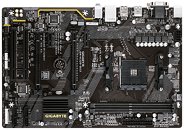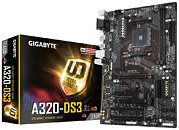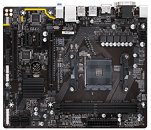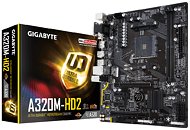- Joined
- Oct 9, 2007
- Messages
- 47,670 (7.43/day)
- Location
- Dublin, Ireland
| System Name | RBMK-1000 |
|---|---|
| Processor | AMD Ryzen 7 5700G |
| Motherboard | Gigabyte B550 AORUS Elite V2 |
| Cooling | DeepCool Gammax L240 V2 |
| Memory | 2x 16GB DDR4-3200 |
| Video Card(s) | Galax RTX 4070 Ti EX |
| Storage | Samsung 990 1TB |
| Display(s) | BenQ 1440p 60 Hz 27-inch |
| Case | Corsair Carbide 100R |
| Audio Device(s) | ASUS SupremeFX S1220A |
| Power Supply | Cooler Master MWE Gold 650W |
| Mouse | ASUS ROG Strix Impact |
| Keyboard | Gamdias Hermes E2 |
| Software | Windows 11 Pro |
GIGABYTE introduced one of the first ATX form-factor motherboard based on AMD's new entry-level chipset for socket AM4 processors, the A320-DS3. The company also launched the micro-ATX A320M-HD2. Besides a slim feature-set, the A320 chipset lacks support CPU overclocking, making these boards better suited for the 7th generation A-series "Bristol Ridge" APUs than the unlocked Ryzen "Summit Ridge" processors, although they do come with Ryzen support out of the box.
Besides one PCI-Express 3.0 x16 slot, the A320-DS3 features a PCI-Express 2.0 x4 (x16) slot, and two each of gen 2.0 x1 and legacy PCI slots. You also get two DDR4 DIMM slots, two 10 Gb/s USB 3.1 type-A ports, 6-channel HD audio, gigabit Ethernet, and display outputs that include DVI and D-Sub. The A320M-HD2, on the other hand, features two PCIe gen 2.0 x1 slots, besides a legacy PCI slot, and the gen 3.0 x16 slot. Most of its feature-set is similar to its ATX sibling, except it also offers an HDMI display output. Expect sub-$80 pricing for the two.




View at TechPowerUp Main Site
Besides one PCI-Express 3.0 x16 slot, the A320-DS3 features a PCI-Express 2.0 x4 (x16) slot, and two each of gen 2.0 x1 and legacy PCI slots. You also get two DDR4 DIMM slots, two 10 Gb/s USB 3.1 type-A ports, 6-channel HD audio, gigabit Ethernet, and display outputs that include DVI and D-Sub. The A320M-HD2, on the other hand, features two PCIe gen 2.0 x1 slots, besides a legacy PCI slot, and the gen 3.0 x16 slot. Most of its feature-set is similar to its ATX sibling, except it also offers an HDMI display output. Expect sub-$80 pricing for the two.




View at TechPowerUp Main Site






 It doesn't matter as I really have no money to upgrade, but one can always dream.
It doesn't matter as I really have no money to upgrade, but one can always dream.